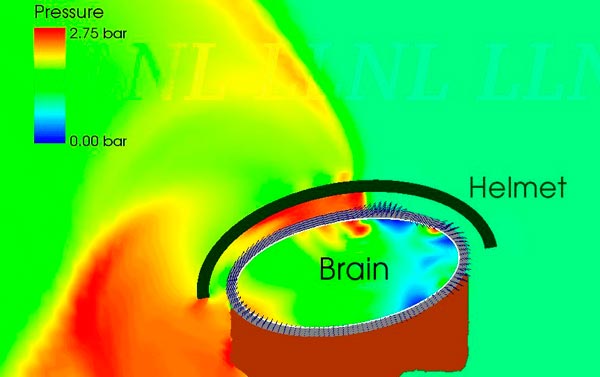
A common battlefield brain injury could originate in the blast waves of nearby explosions, even though such waves cause relatively small accelerations of a soldier’s body. That is the conclusion of physicists in the US who have used computer simulations to study the causes of traumatic brain injury (TBI), a poorly understood condition that appears to be on the increase.
According to the simulations, the blast waves of grenades, landmines and other devices can bypass a soldier’s helmet, distort the skull and inflict potentially dangerous loads on the brain. These loads may be sufficient to cause TBI, even when there has been no contact with shrapnel from the explosion.
“This is a potential new mechanism,” explains William Moss, a physicist at Lawrence Livermore National Laboratory (LLNL) in California and an author of the study. “There are so many candidate possibilities [for TBI] that have been put out by the Department of Defense and others – they’re frantically searching for an answer to this problem.”
TBI has many symptoms and can lead to disabilities or even death. It has become more prevalent as modern armour has cut the number of outright kills from explosives, but no one is sure of the cause. Physicians know that it is linked to explosions, but just which of the many effects of explosions – the impact of shrapnel, the inhalation of toxic gas, or the blast itself, perhaps – has been a mystery.
A model soldier
Moss’s group has now shown how a blast wave could result in TBI. Their simulation is a matrix with a 2.3 kg charge of C4 high explosive situated roughly 4 m from a body with a simplified head containing three layers: a skull, a layer of spinal fluid and a brain. With knowledge of how the pressure front generated by a C4 explosion travels through the air, and by characterizing the material properties of the three head layers, the researchers could calculate the brain’s response.
A normal, direct impact of an explosion damages the body through an extremely high acceleration. The US group discovered that the accelerations from blast waves are far smaller yet at the same time are able to squeeze the skull and create pressure gradients that are much larger, at several atmospheres per centimeter. These pressure gradients can deform the skull by 50 µm, which for a confined brain is enough to cause serious injury. Even with an added Kevlar helmet, the simulations exposed dangerous loads that could potentially lead to TBI.
“When we sat down and compared [the predictions] to guesses from doctors and biometricians of what stress levels they thought might be bad, we were in the same order of magnitude,” says Michael King, Moss’s colleague at LLNL.
Anthony Strong, a neurosurgeon at King’s College London, thinks the study makes “interesting reading”. “I have seen one or two teenage patients with head injuries where the inference was inescapable that their skull, at least at that age, must be more flexible than we usually assume,” he adds. “The only problem for me is that I have no way of knowing whether the assumptions made [in this study] about skull elasticity are reasonable.”
Funding required
The US group – which includes Eric Blackman of the University of Rochester – agrees that some of the materials included in the simulations, particularly the Kevlar, should ideally be better characterized. However, the researchers have not yet secured funding to continue their research. If they do get the opportunity to continue, they say they would improve the fidelity of the model and evaluate different types of armour.
In the meantime, the study may encourage the military to reconsider the design of helmets, and to focus on the type of data collected for studying battlefield injuries. Currently, the US military fits some soldiers with accelerometers and single-point pressure gauges to collect data on explosion impacts, but Moss and King suggest that more sophisticated instruments, including more pressure gauges and strain gauges, are needed to completely determine the nature of the injury.
The research will be reported in Physical Review Letters. A preprint is available at arXiv:0809.3468.



